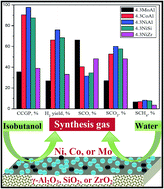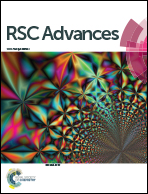Roles of supports (γ-Al2O3, SiO2, ZrO2) and performance of metals (Ni, Co, Mo) in steam reforming of isobutanol†
Abstract
The production of synthesis gas from bio-isobutanol in an integrated biorefinery is a novel approach for its downstream conversion to hydrocarbon fuels and organic chemicals. The present article provides a systematic examination of the structure–activity correlation of various supported transition metal catalysts, xMS (x mmol metal, M (Ni, Co, and Mo) supported on S (Al, Si, and Zr for γ-Al2O3, SiO2, and ZrO2 respectively)) for steam reforming (SR) of bio-isobutanol. The activity of the catalyst was strongly influenced by metal-support interaction as reflected by metal dispersion, metal crystallite size, and extent of bulk metal/metal oxide. The catalytic activity increased in the order of 4.3NiZr < 4.3NiSi < 4.3NiAl and 4.3MoAl < 4.3CoAl < 4.3NiAl. 7.3CoAl exhibited consistent catalytic activity up to 12 h of time-on-stream. The hydrogen yield was boosted with rise of temperature and steam-to-carbon mole ratio (SCMR) with concurrent drop of selectivity to methane. The selectivity to CO reduced with increasing SCMR and decreasing temperature. Furthermore, spent catalysts were characterized to elucidate the effect of metal and support on the nature of coke formed and chemical transformation of the catalyst during SR.


 Please wait while we load your content...
Please wait while we load your content...